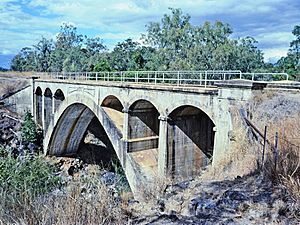Deep Creek Railway Bridge facts for kids
Quick facts for kids Deep Creek Railway Bridge |
|
|---|---|

Deep Creek Railway Bridge, 1994
|
|
| Location | Mungar-Monto railway line, Didcot, North Burnett Region, Queensland, Australia |
| Design period | 1900 - 1914 (early 20th century) |
| Built | 1905 |
| Architect | William Pagan |
| Official name: Deep Creek Railway Bridge, Chowey | |
| Type | state heritage (built) |
| Designated | 21 October 1992 |
| Reference no. | 600031 |
| Significant period | 1900s (fabric) |
| Significant components | abutments - railway bridge |
| Builders | Day labour |
| Lua error in Module:Location_map at line 420: attempt to index field 'wikibase' (a nil value). | |
The Deep Creek Railway Bridge is a historic railway bridge located in Didcot, Queensland, Australia. It is part of the Mungar-Monto railway line. This bridge was designed by a famous engineer named William Pagan. It was built in 1905 by a team of workers. The bridge is very important because of its unique design. It is now protected as a heritage site.
Contents
Building the Deep Creek Bridge
The Mungar-Monto railway line was being built in stages. Work stopped for a while in the 1890s. It started again in 1905. This was part of a special program by the Railway Department. They used their own workers, known as "day labour."
Who Designed the Bridge?
William Pagan was the Chief Engineer for the railway at that time. He was in charge of designing many important structures. He personally checked the progress of the Deep Creek bridge in March 1905. The bridge was finished quickly. The railway line officially opened on December 21, 1905. Pagan himself called it "a concrete bridge of somewhat novel design." This means it had a new and interesting design.
Why Was This Bridge Special?
The Deep Creek Railway Bridge was a big step forward in bridge building. It used concrete arches, which was quite new for its time. Before this, other bridges had smaller concrete arches. For example, the Swansons Rail Bridge had 33-foot arches. The Petrie Terrace road bridge had a 47-foot arch. The Deep Creek bridge was much bigger. Its main arch was 80 feet wide! This made it one of the longest concrete arch bridges in Australia at the time.
What Does the Bridge Look Like?
The Deep Creek bridge is a type of bridge called a concrete viaduct. A viaduct is like a long bridge made of arches. This bridge has a very large 80-foot concrete arch in the middle. On each side of this big arch, there are two smaller 15-foot arches.
How the Bridge is Built
The railway tracks sit on top of the bridge. They are laid on wooden sleepers and ballast (small stones). This creates a trough-like shape on top. You can also see the year it was built, 1905, cast into the sides of the bridge.
The bridge is made up of:
- An embankment, which is a raised bank of earth.
- One 15-foot concrete arch. This arch has a ballasted top and concrete supports called abutments.
- One large 80-foot concrete arch. This main arch has four smaller 15-foot spandrel arches. Spandrel arches are smaller arches that fill the space between the main arch and the flat top. This part also has a ballasted top.
- Another 15-foot concrete arch, similar to the first one.
Why is it a Heritage Site?
The Deep Creek Railway Bridge was added to the Queensland Heritage Register on October 21, 1992. This means it is a very important historical site.
A Special Part of History
This bridge is important because it shows how Queensland's history developed. It was one of the first and largest concrete arch bridges of its kind. It was the third bridge of its type built in Australia. Its new design was thanks to Chief Engineer William Pagan.
A Great Achievement
The bridge also shows amazing creative and technical skill for its time. Its design was very innovative. It fit well into the rocky valley of the creek. This bridge truly represents a high level of engineering achievement from the early 1900s.
Connected to Important People
The bridge has a special connection to William Pagan. He was a very important person in Queensland's railway history. His innovative design for this bridge shows his significant work.
Images for kids



